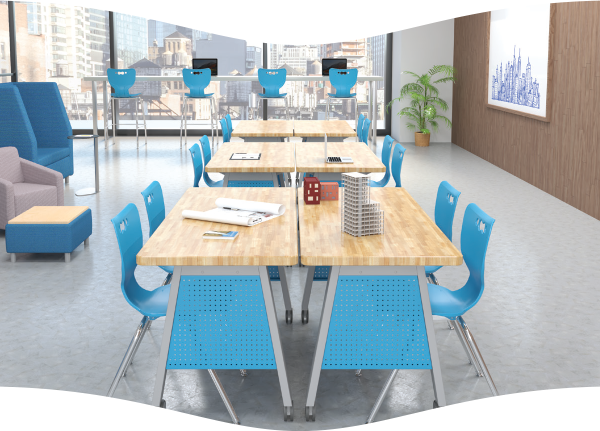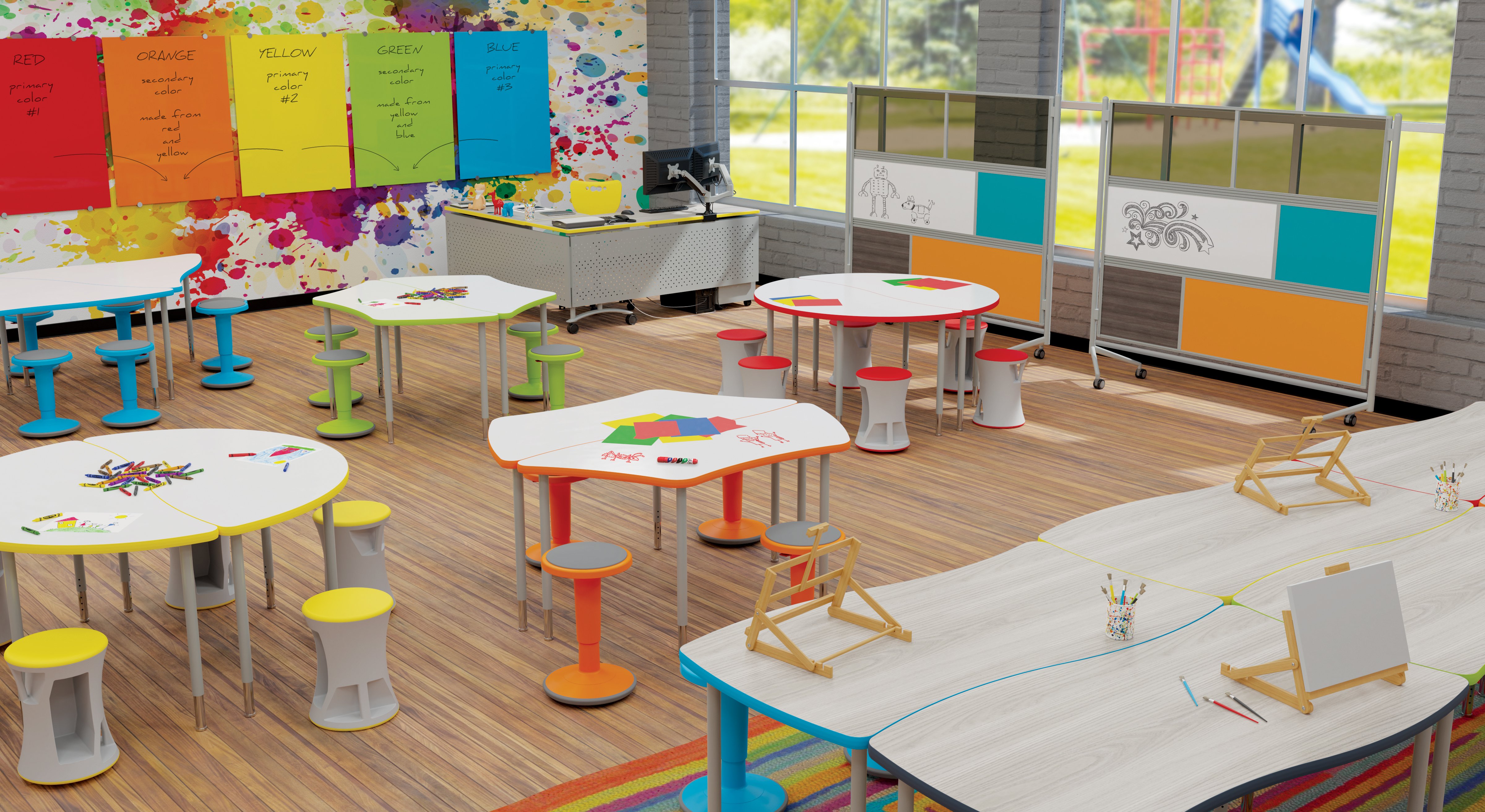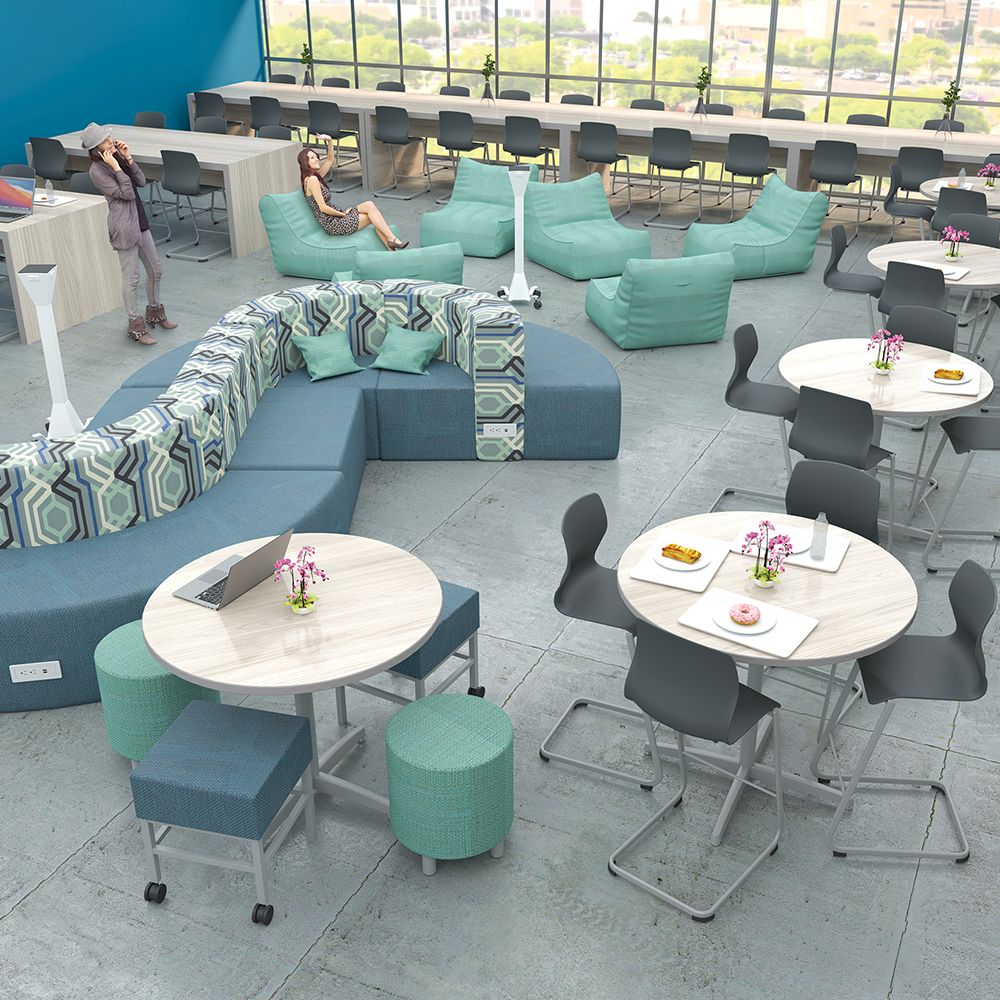6 Considerations for Space Design in a Post-Pandemic World
Posted by MooreCo Inc on Apr 15, 2021 2:31:51 PM

6 Considerations for Space Design in a Post-Pandemic World
In the 1920s, the United States experienced a modern renaissance. An era of economic prosperity, burgeoning art, societal change, and scientific discoveries occurred throughout this decade. There was a boom of energy, hope, and optimism. What had happened just before this decade will resonate with many today. The global pandemic brought on by the Spanish Flu killed over 600,000 Americans. It was a time of sadness, fear, and trial. But what followed was a time we still think of as a new era.
The 21st Century Renaissance
As COVID-19 positivity rates begin to decline due to vaccinations nationwide, America is once again on the precipice of another modern renaissance. Historians suggest we can expect the same sense of economic and social renewal that took place in the 1920s. And in the same way that the era ushered in new forms of art and architecture, design will be affected by events of the last year. But unlike the art deco aesthetic that dominated the time of the flapper, the design era in the 2020s will be based on human health and happiness.
Designing for the 2020s
For designers, employers, and educators, it’s important to know what to prepare for as you welcome your people back into the spaces that have been distanced for over a year. That’s why the Thrive Philosophy was created; to promote awareness of the keys to human health and how they may factor into design. For designers in the 2020s to thrive, they will need to make sure the people they design for are able to thrive as well. Here are the six developmental principles and how we’ll see them factor into design in the next decade.
1. Social Emotional Development
This development stage is marked by peer relationships and positive interactions and is crucial to productivity from adolescence to our senior years. Cooperative learning activities and collaborative experiences encourage daily peer-to-peer interaction. In youth, that may be extracurricular activities such as service clubs or leadership groups to simulate real-world social situations. How young people learn to behave in these settings will guide their behavior later in life. It also sets the foundation for empathy and emotional intelligence.
How to Design for Social Emotional Development

Dr. Maurice Elias, Ph.D. is the Director of Rutgers' Social-Emotional & Character Development Lab. He recently spoke at MooreCo's Thrive Forward webinar. He spoke about how environments can lead to a sense of community to enhance collaboration. "Organized environments can drive communication, interaction, team building, and creative thinking."
The key to designing environments that support social-emotional development for adolescents and coworkers is creating spaces where people can connect. Furniture, technology, and tools should integrate to facilitate communication, collaboration, and teamwork. Visual communication tools for writing ideas can bring people together and let their ideas be heard. Here, the Compass Tables are paired with the Hierarchy 4-Leg Chairs, and soft seating for a relaxed environment. When designing for social-emotional development, make it a priority to envision people gathering, and feeling relaxed and included.
2. Physical Development
A healthy body is the key to a healthy mind. Physical development during adolescence lays the foundation for healthy habits surrounding fitness and nutrition in adulthood. Unsupported posture and repetitive stress at work and at school can lead to musculoskeletal injuries, reduced productivity, and absenteeism.
How to Design for Physical Development

Ergonomics, supportive posture, circulation, and movement are integral components of active learning and working environments. Dr. Lisa Harris and Dr. Amy Rohsner are ergonomics specialists and recently spoke at MooreCo’s Thrive Forward webinar. They placed emphasis on the ability to move throughout the day as one key to optimal health and well-being. As Dr. Harris said, “We want to think about the fact that postures are not necessarily static.
When you add physical movement of change of posture, you’re allowing muscles to relax. Having the ability to allow movement in and out of that position is ideal.” Wobble stools, rocking chairs, ergonomic desk chairs, and tables designed for sitting and standing will help support the spine and optimal movement all day long.
3. Intellectual Development
Intellectual development refers to the ability to understand and reason. In early adolescence, curiosity reaches new heights. Adolescents are eager to explore new interests and learn about new topics. Experience plays a central role in brain growth. Intellectual development favors active learning and peer-to-peer interactions, an ongoing process that continues through adulthood.
How to Design for Intellectual Development

Dr. Jessica Church-Lang is head of the Texas Learning Disabilities Research Center at the University of Texas, and an expert on intellectual development. When she spoke at MooreCo's Thrive Forward webinar, she noted that a key to thriving throughout adolescence in learning environments is for each student to find the way they learn best. Whether it's alone or in a group setting, feeling included and having a social connection is still very important.
"What we see really is a change from social cognition over time to a growing interest in social connection. You have this increased ability to think abstractly." The key takeaway from this stage for designers is that everyone learns differently, and the most productive environments (whether at school or work) are those that offer multiple ways to learn, think, and grow. As a designer, be sure to include desks and grouped configurations for shared ideas, as well as privacy pods for those who learn and work best alone. The more options for seating throughout a room, the better.
4. Moral Development
Many of the attitudes, beliefs, and values that young adolescents develop remain with them into adulthood. During moral development, the brain transitions from a self-centered perspective to consideration toward others. Adolescents are encouraged to explore challenging, high-level concepts that allow them to define the virtues that will guide them throughout life. Moral development evolves with time, and as society changes, so do our moral values.
How to Design for Moral Development

Cara Biasucci is the Director of Ethics Education at the Center for Leadership and Ethics at the University of Texas. At MooreCo's Thrive Forward webinar, she discussed the importance of ethics education in schools and the workplace, and how learning compassion can create unity and acceptance in organizations. "We're in environments, for example, where people are acting ethically, we're going to be more likely to also follow suit."
To facilitate this stage among schoolchildren, educators offer some freedoms, while maintaining boundaries, authority, and rules to follow. Community tables where students can co-work and engage support moral development. In the workplace, visual products that communicate corporate culture and values can help create a positive moral environment. Giving everyone a seat at the table promotes inclusion. This will help to combat bias and increase morale and collaboration in every workplace. Pictured in this environment are the Compass tables and Visionary Glass Walls so everyone can be seen and heard.
5. Psychological Development
When students are in tune with their emotional and mental state, they are better able to navigate the world around them. Psychological development is a time for identity formation as adolescents push themselves to take risks, develop perseverance, and discover independence.
How to Design for Psychological Development

Associate Professor of Psychology at Rice University, Dr. Chris Fagundes, recently presented at the MooreCo Thrive webinar, speaking about factors that influence psychological wellbeing in schools and the workplace. He mentioned how important it is for young adults to feel they are included, saying. "What we see here is that if adolescence have this high need to belong, meaning that they're part of a subset of adolescence, that really crave being part of the group."
To help encourage independence and self-reliance — where students can make mistakes and learn from them — spaces can be designed specifically for those who need to reorganize or catch up. In the workplace, designers can tap employee input into what best stimulates their mind to perform, as well as provide varied spaces for rest and socialization throughout the work day. Bistro-style seating in a higher learning or work environment, paired with all-day charging stations and soft seating will create a feeling of fun, while encouraging conversation and a sense of belonging.
6. Spiritual Development
Spirituality is not bound to a religious practice or place of worship. Spiritual development refers to one’s connection with the human spirit and one’s self as opposed to material or physical possessions. Mindfulness in the workplace and in schools is becoming commonplace, as leaders understand the positive effects on mind and body of finding a daily time for reflection.
How to Design for Spiritual Development

Will Le Strange is a Feng Shui expert who recently spoke at MooreCo's Thrive Forward webinar. He spoke about designing spaces that encourage harmony, saying that including elements found in nature help to boost mood and create a sense of calm. "When we're dealing with emotions, or the emotions of a place or design, we can use these elements to inspire us, or guide us in our design journey."
Since mindfulness is at the core of spirituality in today’s learning and working environments, designers must include items that help to conjure a closeness to nature, encouraging inhabitants to feel reconnected with their environment. This will promote a sense of inner peace and calm. Soothing colors, soft seating, and curved furniture will help to evoke tranquil emotions. Since we are now in the age where Zoom sessions and meetings are the norm, connection is more important than ever. Provide spaces for reflection, with plenty of natural light, a reliable internet connection for meetings, and smart boards and tools to help everyone stay connected, no matter the circumstances.
We’re Here to Help
Curious about learning more about the 6 developmental principles for optimal human development? We will be highlighting each of these aspects and sessions from our spring webinar in upcoming posts, including sessions specifically for and by designers. Follow us for more information for design in a new era. We are here to help you thrive as we head into the new roaring 20s.
Learn more about our Thrive Philosophy:
Topics: Insider, Design, Human Development, Active Classroom, Designer's Corner, MooreCo Workplace, Ergonomics, Thrive

